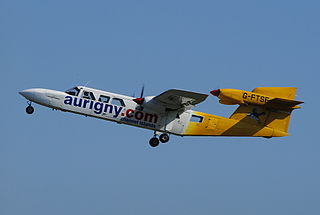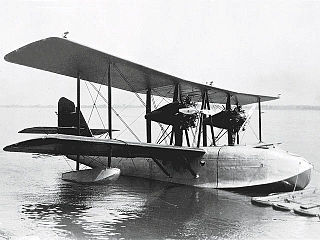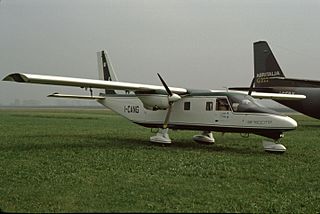
The Britten-Norman Trislander is an 18-seat three-engined piston-powered civilian utility aircraft produced in the 1970s and early 1980s by Britten-Norman of Britain. These STOL capable aircraft were produced on the Isle of Wight. They were also produced in Romania, and delivered via Belgium to Britain for their certification. A number of commuter airlines operated the Trislander in scheduled passenger services.

The Britten-Norman BN-2 Islander is a British light utility aircraft and regional airliner designed and originally manufactured by Britten-Norman of the United Kingdom. Still in production, the Islander is one of the best-selling commercial aircraft types produced in Europe. Although designed in the 1960s, over 750 are still in service with commercial operators around the world. The aircraft is also used by the British Army and police forces in the United Kingdom and is a light transport with over 30 military aviation operators around the world.

The Aero L-60 Brigadýr was a small, high-wing propeller-driven Czechoslovakian STOL utility aircraft developed for both civil and military use. A prototype, designated XL-60, with Argus As 10C engine, first flew on December 24, 1953, but it was not successful. The plane was thoroughly redesigned and the second improved prototype, with M-208B flat-six engine, flew on June 8, 1954. The aircraft's configuration bears a strong resemblance to the Fieseler Fi 156 "Storch" licence-produced in Czechoslovakia during and after World War II, and which this aircraft was intended to replace. By the end of production in 1960, 273 had been built by Aero, including an improved version, the L-160 with an all-metal tail.

The Piper PA-38-112 Tomahawk is a two-seat, fixed tricycle gear general aviation airplane, originally designed for flight training, touring and personal use.

The Cessna T303 Crusader is an American six-place light twin-engined aircraft built by Cessna Aircraft Company. Production ceased in 1986.

The Cessna Model 404 Titan is an American twin-engined, light aircraft built by Cessna Aircraft. It was that company's largest twin piston-engined aircraft at the time of its development in the 1970s. Its US military designation is C-28, and Swedish Air Force designation Tp 87.

The Harbin Y-11 is a high wing twin-engine piston utility and geological survey aircraft built by Harbin Aircraft Manufacturing Corporation (HAMC).

The Canadian Vickers Vancouver was a Canadian transport/patrol flying boat of the 1930s built by Canadian Vickers.

The NDN Firecracker is a single-engine aircraft designed as a military trainer.

The Let L-200 Morava is a two-engine touring and light passenger aircraft of the 1960s, designed and produced by Let Kunovice in the Czech Republic.

The DINFIA IA 45 Querandi was a 1950s Argentine twin-engined light transport aircraft built by the DINFIA.

The Evangel 4500 was a 1960s American twin-engined light passenger/cargo monoplane built by the Evangel Aircraft Corporation.

The Reid Rambler, later known under the Curtiss-Reid brand after Reid was purchased by Curtiss, was a biplane trainer/sport aircraft built in Canada in the early 1930s and used in small numbers as a trainer aircraft by the Royal Canadian Air Force.

The Wing D-1 Derringer is an American light twin-engined two-seat monoplane tourer designed by John Thorp and developed by the Hi-Shear Corporation and built by the Wing Aircraft Company.

The Vulcanair SF.600 Canguro was a feederliner developed in Italy in the late 1970s. Despite a number of attempts to put the aircraft into series production, only a small number were ever built. The Canguro was a high-wing cantilever monoplane of conventional configuration with a fuselage of rectangular cross-section and a high-set tail. The tricycle undercarriage was not retractable, and its main units were carried on sponsons on the fuselage sides. SIAI Marchetti provided funding towards the construction of the prototype, and constructed this aircraft at the former Aviamilano plant. After flight testing proved positive, the type was put on sale, but failed to attract buyers in any number, even when the original piston engines were exchanged for turboprops and retractable undercarriage was offered as an option.

The NAC Fieldmaster was a British agricultural aircraft of the 1980s. A turboprop powered single-engined monoplane, it was built in small numbers and used both as a cropsprayer and a firefighting aircraft.

The Turbay T-3A was an Argentine twin-engined seven-seater light transport of the 1960s. A single example was built, but no production followed.

The Pilatus PC-8D Twin Porter was a Swiss ten-seat light transport built by Pilatus Aircraft. The type did not go into production and only one was built.
The Grob G 110 was a single-engined two-seat light aircraft, made mainly of glassfibre, which was designed and built by the German manufacturer Grob Aircraft in the early 1980s. Two prototypes were built, with the first example making its maiden flight on 6 February 1982, but development was abandoned after the first prototype crashed later that year.

The Vega Model 2 Starliner was a prototype five-seat feeder airliner produced by the Vega Airplane Company, a subsidiary of Lockheed. It was designed to be powered by an unusual powerplant, consisting of two Menasco piston engines coupled together to drive a single propeller. A single example was built, flying in 1939, but no production followed.



















